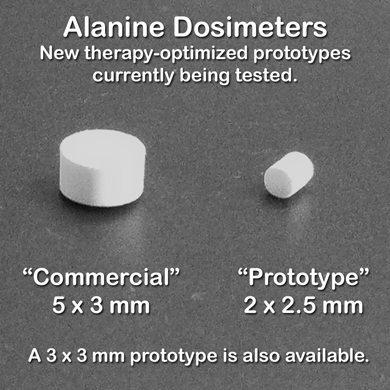Summary
Due to overlap with the Uniformed Services University of the Health Sciences (USUHS) in missions, scientific interests, expertise, and instrumental requirements, it was determined to be mutually beneficial to establish a joint USUHS/NIST EPR project, located at the NIST, to facilitate collaboration between the institutions. This collaboration will serve to bring together the USUHS expertise in radiation physics, small small-field dosimetry, and military-specific biodosimetry requirements with the NIST expertise in alanine dosimetry, biodosimetry and dose assessment, and spectroscopic analysis.
Description

Developments in radiotherapy have significantly increased the use of small fields in stereotactic procedures and IMRT fields composed of small fields. Ionization chambers are not always suitable where situations of high dose gradients, time-dose variance, and non-uniform beam distributions are encountered. Volume averaging and lack of electronic equilibrium complicate the use of ionization chambers for the dosimetry of small photon beams. An international protocol was under development by the IAEA and the AAPM to address the difficult problems of small-field dosimetry in radiation therapy (e.g., Gamma Knife, IMRT, Cyber Knife, TomoTherapy). One promising path from national standards in large reference fields is the use of alanine/EPR dosimetry. The project was being conducted on multiple levels in parallel:
- Field Tests with 5 mm Alanine Dosimeters. An international comparison of Gamma Knife units is underway organized the U. Pittsburgh Cancer Center and using NIST's existing alanine dosimetry service. To date, 31 facilities have participated from North America, Europe, and Asia. The mean deviation between the planned and measured absorbed dose was within the range of the alanine system uncertainty; a manuscript detailing this work is in preparation.
- Redesign the Alanine Dosimeter. Commercial alanine dosimeters are considered too large (5 mm diameter) for small field dosimetry. Working with the dosimeter manufacturer, Gamma Service (Germany), we received alanine dosimeters with dimensions of 2 mm and 3 mm. Preliminary tests have proved the dosimeter sufficiently sensitive for therapy level dosimetry.
- Modify Measurement Protocol. The sensitivity of the alanine dosimetry system is proportional to the dosimeter mass. The plan to extend the alanine dosimetry range to therapy levels while reducing their mass will require modifications to the EPR spectrometer hardware and software. In collaboration with Bruker Biospin (USA), preliminary modifications to the system have been made and tested at the Bruker corporate facility.
- Build New Facilities/Services. A Memorandum of Understanding was signed between NIST and the Uniformed Services University of the Health Sciences (USUHS) that resulted in the recent transfer of their EPR spectrometer to NIST. The second spectrometer will complement the existing EPR spectrometer at NIST and allow for system development to occur on one while the other can be dedicated to service work. USUHS also has a TomoTherapy treatment facility that can be leveraged for testing of the system.
The collaboration served as a state-of-the-art EPR research center for the study of radiation dosimetry, radiation accident dose assessment and mapping, and the effects of ionizing radiation on various materials, in order to improve scientific understanding of radiation therapy dose distributions, radiation accident triage procedures, and radiosensitive materials. At the center of the effort is a state-of-the-art USUHS EPR spectrometer that will be used to establish a protocol for a new prototype alanine dosimeter that is better suited for small-field dosimetry. The challenge was to balance the sensitivity demands of the biodose realm and the smaller mass dosimeter with the ultimate goal to develop a calibration service that will provide traceability to national standards.

